Directional and Weighted Urban Network Analysis in the Chengdu-Chongqing Economic Circle from the Perspective of New Media Information Flow
Abstract
:1. Introduction
2. Overview of the Study Area and Data Sources
2.1. The Study Area
2.2. Data Sources
3. Methods
3.1. Logical Framework
3.2. Rate of Flow
3.3. Interconnection Features
3.3.1. The Interrelation Quantity
3.3.2. The Degree of Interconnection Imbalance
3.4. Centrality Analysis
3.4.1. The Degree of Centrality
3.4.2. QAP Regression Analysis
4. Results
4.1. Characteristics of Directional Information Flow
4.2. Analysis of the Interconnection of Information Flow
4.3. Centrality Analysis
4.3.1. Centrality Differences
4.3.2. Influencing Factors of Centrality Differences
5. Discussion and Conclusions
5.1. Discussion
5.1.1. Directional Flow Analysis Further Sub-Divides the Non-Directional Network
5.1.2. Centrality Evaluations Accounting for Status and Direction Information
5.1.3. QAP Analysis Was Used to Analyze the Mechanisms Affecting Centrality Differences
5.1.4. Thinking and Outlook
5.2. Conclusions
Author Contributions
Funding
Data Availability Statement
Acknowledgments
Conflicts of Interest
References
- Zhang, F.; Ning, Y.; Lou, X. The evolutionary mechanism of China’s urban network from 1997 to 2015: An analysis of air passenger flows. Cities 2021, 109, 103005. [Google Scholar] [CrossRef]
- Carroll, W.K. Global Cities in the Global Corporate Network. Environ. Plan. A Econ. Space 2007, 39, 2297–2323. [Google Scholar] [CrossRef]
- Neal, Z.P.; Derudder, B.; Taylor, P. Forecasting the world city network. Habitat Int. 2020, 106, 102146. [Google Scholar] [CrossRef]
- Taylor, P.J.; Csomos, G. Cities as control and command centres: Analysis and interpretation. Cities 2012, 29, 408–411. [Google Scholar] [CrossRef]
- Wall, R.S.; Van der Knaap, G.A. Sectoral Differentiation and Network Structure Within Contemporary Worldwide Corporate Networks. Econ. Geogr. 2011, 87, 267–308. [Google Scholar] [CrossRef]
- Zhang, Y.; Song, R.; Zhang, K.; Wang, T. The Characteristics and Modes of Urban Network Evolution in the Yangtze River Delta in China from 1990 to 2017. IEEE Access 2021, 9, 5531–5544. [Google Scholar] [CrossRef]
- Castells, M. The Informational City: Information Technology, Economic Resturcturing and the Urban-Regional Progress; Basil Blackwell: Oxford, UK, 1989. [Google Scholar]
- Taylor, P.J.; Hoyler, M.; Verbruggen, R. External Urban Relational Process: Introducing Central Flow Theory to Complement Central Place Theory. Urban Stud. 2010, 47, 2803–2818. [Google Scholar] [CrossRef] [Green Version]
- Zhen, F.; Qin, X.; Ye, X.; Sun, H.; Luosang, Z. Analyzing urban development patterns based on the flow analysis method. Cities 2019, 86, 178–197. [Google Scholar] [CrossRef]
- Antoine, S.; Sillig, C.; Ghiara, H. Advanced Logistics in Italy: A City Network Analysis. Tijdschr. Voor Econ. En Soc. Geogr. 2017, 108, 753–767. [Google Scholar] [CrossRef]
- Hesse, M.; Rodrigue, J. The transport geography of logistics and freight distribution. J. Transp. Geogr. 2004, 12, 171–184. [Google Scholar] [CrossRef]
- Veenstra, A.W.; Mulder, H.M.; Sels, R.A. Analysing container flows in the caribbean. J. Transp. Geogr. 2005, 13, 295–305. [Google Scholar] [CrossRef]
- Abel, G.; Sander, N. Quantifying Global International Migration Flows. Science 2014, 343, 1520–1522. [Google Scholar] [CrossRef] [PubMed]
- Yang, Z.; Hua, Y.; Cao, Y.; Zhao, X.; Chen, M. Network Patterns of Zhongyuan Urban Agglomeration in China Based on Baidu Migration Data. ISPRS Int. J. Geo-Inf. 2022, 11, 62. [Google Scholar] [CrossRef]
- Cui, C.; Wu, X.; Liu, L.; Zhang, W. The Spatial-Temporal Dynamics of Daily Intercity Mobility in the Yangtze River Delta: An Analysis Using Big Data. Habitat Int. 2020, 106, 102174. [Google Scholar] [CrossRef]
- Lin, J.; Wu, K.; Yang, S.; Liu, Q. The Asymmetric Pattern of Population Mobility during the Spring Festival in the Yangtze River Delta Based on Complex Network Analysis: An Empirical Analysis of“Tencent Migration” Big Data. ISPRS Int. J. Geo-Inf. 2021, 10, 582. [Google Scholar] [CrossRef]
- Puura, A.; Silm, S.; Masso, A. Identifying relationships between personal social networks and spatial mobility: A study using smartphone tracing and related surveys. Soc. Netw. 2022, 68, 306–317. [Google Scholar] [CrossRef]
- Vega, I.; Vessuri, H. Science and mobility: Is physical location relevant? Technol. Soc. 2008, 30, 71–83. [Google Scholar] [CrossRef]
- Zhang, W.; Derudder, B.; Wang, J.; Shen, W. Regionalization in the Yangtze River Delta, China, from the perspective of inter-city daily mobility. Reg. Stud. 2017, 52, 528–541. [Google Scholar] [CrossRef]
- Devriendt, L.; Boulton, A.; Brunn, S.; Derudder, B.; Witlox, F. Searching for Cyberspace: The Position of Major Cities in the Information Age. J. Urban Technol. 2011, 18, 73–92. [Google Scholar] [CrossRef]
- Lin, Q.; Xiang, M.; Zhang, L.; Yao, J.; Wei, C.; Ye, S.; Shao, H. Research on Urban Spatial Connection and Network Structure of Urban Agglomeration in Yangtze River Delta-Based on the Perspective of Information Flow. Int. J. Environ. Res. Public Health 2021, 18, 10288. [Google Scholar] [CrossRef]
- Tang, C.; Qiu, P.; Dou, J. The impact of borders and distance on knowledge spillovers—Evidence from cross-regional scientific and technological collaboration. Technol. Soc. 2022, 70, 102014. [Google Scholar] [CrossRef]
- Townsend, A.M. The Internet and the Rise of the New Network Cities, 1969–1999. Environ. Plan. B Plan. Des. 2001, 28, 39–58. [Google Scholar] [CrossRef] [Green Version]
- Taylor, P.J.; Catalano, G.; Walker, D. Exploratory Analysis of the World City Network. Urban Stud. 2002, 39, 2377–2394. [Google Scholar] [CrossRef]
- Ma, F.; Zhu, Y.; Yuen, K.; Sun, Q.; He, H.; Xu, X.; Shang, Z.; Xu, Y. Exploring the Spatiotemporal Evolution and Sustainable Driving Factors of Information Flow Network: A Public Search Attention Perspective. Int. J. Environ. Res. Public Health 2022, 19, 489. [Google Scholar] [CrossRef] [PubMed]
- Segev, E.; Boudana, S. What you google is where you are from: Power and proximity in the global information flow of online searches. Inf. Soc. 2022, 38, 79–99. [Google Scholar] [CrossRef]
- Harwit, E. The Rise and Influence of Weibo (Microblogs) in China. Asian Surv. 2014, 54, 1059–1087. [Google Scholar] [CrossRef]
- Harwit, E. WeChat: Social and political development of China’s dominant messaging app. Chin. J. Commun. 2017, 10, 312–327. [Google Scholar] [CrossRef]
- Wang, H.; Shi, F. Weibo use and political participation: The mechanism explaining the positive effect of Weibo use on online political participation among college students in contemporary China. Inf. Commun. Soc. 2018, 21, 516–530. [Google Scholar] [CrossRef]
- Liu, Z.; Wang, S.; Zhao, M.; Wu, K. Exploratory analysis of directional and weighted urban networks. Geogr. Res. 2013, 32, 1253–1268. (In Chinese) [Google Scholar]
- Pan, Y.; Ma, L.; Tang, H.; Wu, Y.; Yang, Z. Land Use Transitions under Rapid Urbanization in Chengdu-Chongqing Region: A Perspective of Coupling Water and Land Resources. Land 2021, 10, 812. [Google Scholar] [CrossRef]
- Bo, Q. City profile: Chengdu. Cities 2015, 43, 18–27. [Google Scholar] [CrossRef]
- Liu, C.; Wang, C.; Li, Y.; Wang, Y. Spatiotemporal differentiation and geographic detection mechanism of ecological security in Chongqing, China. Glob. Ecol. Conserv. 2022, 35, e02072. [Google Scholar] [CrossRef]
- Pan, H.; Yang, C.; Quan, L.; Liao, L. A New Insight into Understanding Urban Vitality: A Case Study in the Chengdu-Chongqing Area Twin-City Economic Circle, China. Sustainability 2021, 13, 10068. [Google Scholar] [CrossRef]
- Li, J.; Qian, Y.; Zeng, J.; Yin, F.; Zhu, L.; Guang, X. Research on the Influence of a High-Speed Railway on the Spatial Structure of the Western Urban Agglomeration Based on Fractal Theory-Taking the Chengdu-Chongqing Urban Agglomeration as an Example. Sustainability 2020, 12, 7550. [Google Scholar] [CrossRef]
- Mu, N.; Wang, Y.; Wang, M. The Co-evolution of the Regional Logistics Network in the Chengdu-Chongqing Region Based on Node Attraction. Int. J. Comput. Intell. Syst. 2022, 15, 25. [Google Scholar] [CrossRef]
- Yao, Z.; Ye, K.; Xiao, L.; Wang, X. Radiation Effect of Urban Agglomeration’s Transportation Network: Evidence from Chengdu-Chongqing Urban Agglomeration, China. Land 2021, 10, 520. [Google Scholar] [CrossRef]
- Zhao, Y.; Li, J.; Guo, J. Research on network linkage pattern of Chengdu-Chongqing urban agglomeration based on Baidu index. Areal Res. Dev. 2017, 36, 6. (In Chinese) [Google Scholar]
- Krzysztof, J. Visibility and Connections among Cities in Digital Space. J. Urban Technol. 2015, 22, 3–21. [Google Scholar] [CrossRef]
- Bo, W.; Becky, P.Y.L. The hierarchy of cities in Internet news media and Internet search: Some insights from China. Cities 2019, 84, 121–133. [Google Scholar] [CrossRef]
- Anthony, M.T. Network Cities and the Global Structure of the Internet. Am. Behav. Sci. 2001, 44, 1697–1716. [Google Scholar] [CrossRef]
- Limtanakool, N.; Dijst, M.; Schwanen, T. A Theoretical Framework and Methodology for Characterising National Urban Systems on the Basis of Flows of People: Empirical Evidence for France and Germany. Urban Stud. 2007, 44, 2123–2145. [Google Scholar] [CrossRef]
- Scott, J. Social Network Analysis; Sage Publications Ltd.: London, UK, 2000. [Google Scholar]
- Liu, J. Whole Network Approach, 3rd ed.; Truth & Wisdom Press: Shanghai, China, 2019. (In Chinese) [Google Scholar]
- Jiao, J.; Wang, j.; Jin, F.; Wang, H. Research on the impact of high-speed railway on urban network structure: Based on the analysis of railway passenger trains. J. Geogr. 2016, 71, 265–280. (In Chinese) [Google Scholar]
- Krackardt, D. QAP partialling as a test of spuriousness. Soc. Netw. 1987, 9, 171–186. [Google Scholar] [CrossRef]
- Huang, Y.; Hong, T.; Ma, T. Urban network externalities, agglomeration economies and urban economic growth. Cities 2020, 107, 102882. [Google Scholar] [CrossRef]
- Shi, S.; Wong, S.; Zheng, C. Network capital and urban development: An inter-urban capital flow network analysis. Reg. Stud. 2022, 56, 406–419. [Google Scholar] [CrossRef]
- Wang, S.; Song, Y.; Wen, H.; Li, J. Network structure of urban agglomeration in the Yangtze River economic belt from the perspective of two-way connection: Based on time distance and social network analysis method. Econ. Geogr. 2019, 39, 73–81. (In Chinese) [Google Scholar]
- Li, Y.; Zhuang, X.; Wang, J.; Dong, Z. Spatial linkage of volatility spillovers and its explanation across China’s interregional stock markets: A network approach. Appl. Econ. Lett. 2020, 28, 668–674. [Google Scholar] [CrossRef]
- Xu, H.; Cheng, L. The study of the influence of common humanistic relations on international services trade-from the perspective of multi-networks. Phys. A-Stat. Mech. Its Appl. 2019, 523, 642–651. [Google Scholar] [CrossRef]
- Yan, Z.; Qiu, X.; Du, D.; Grimes, S. Transboundary Water Cooperation in the Post-Cold War Era: Spatial Patterns and the Role of Proximity. Int. J. Environ. Res. Public Health 2022, 19, 1503. [Google Scholar] [CrossRef] [PubMed]

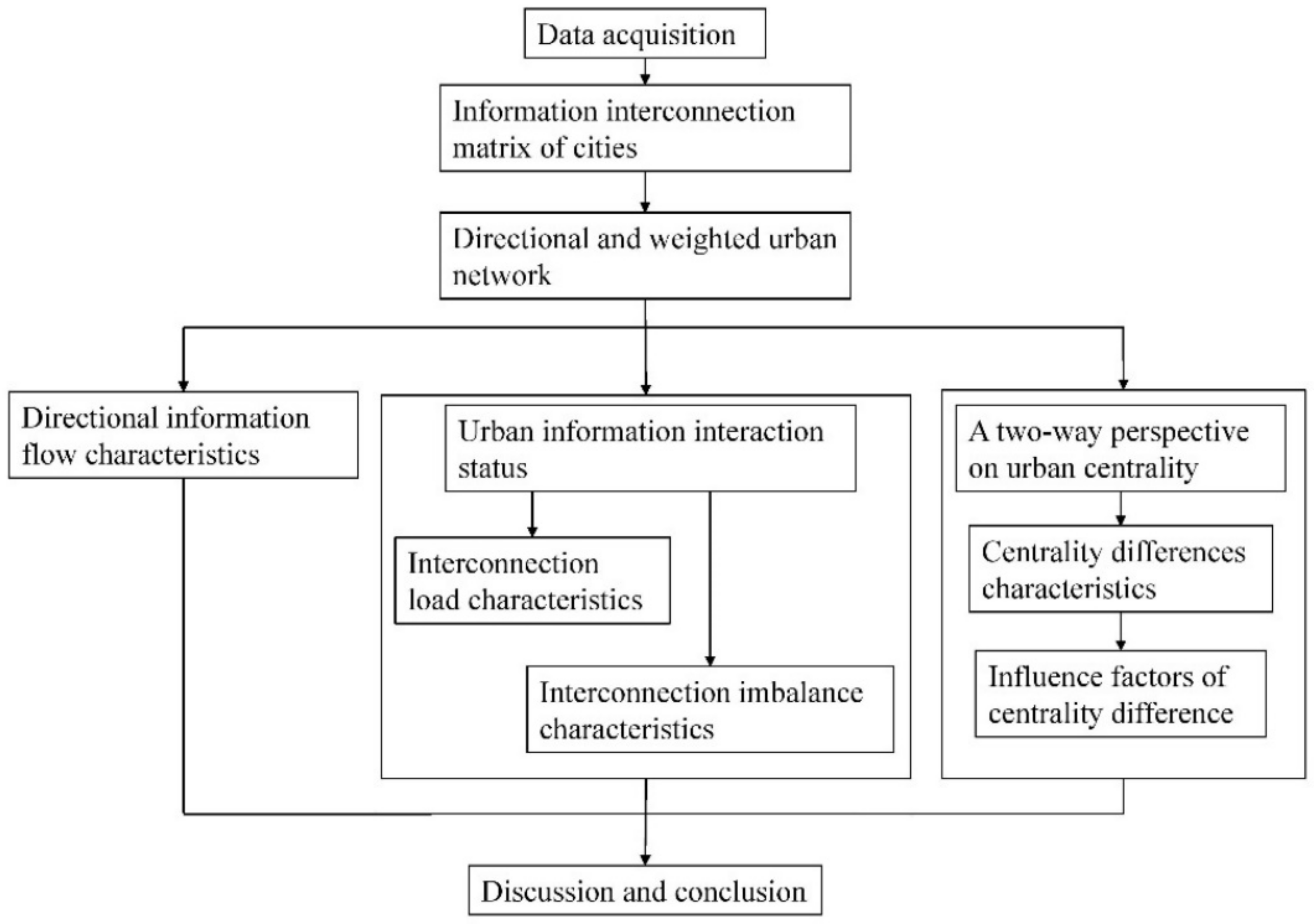
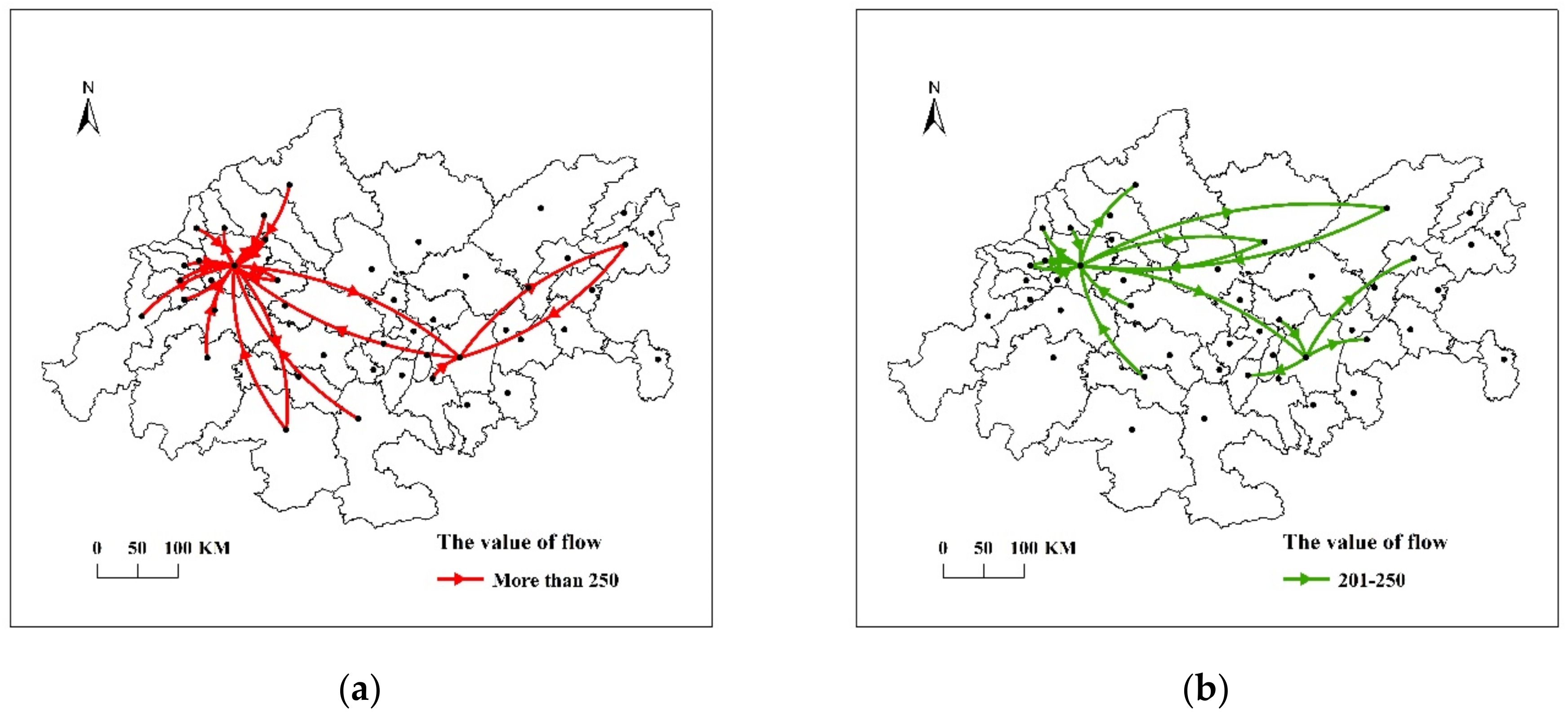
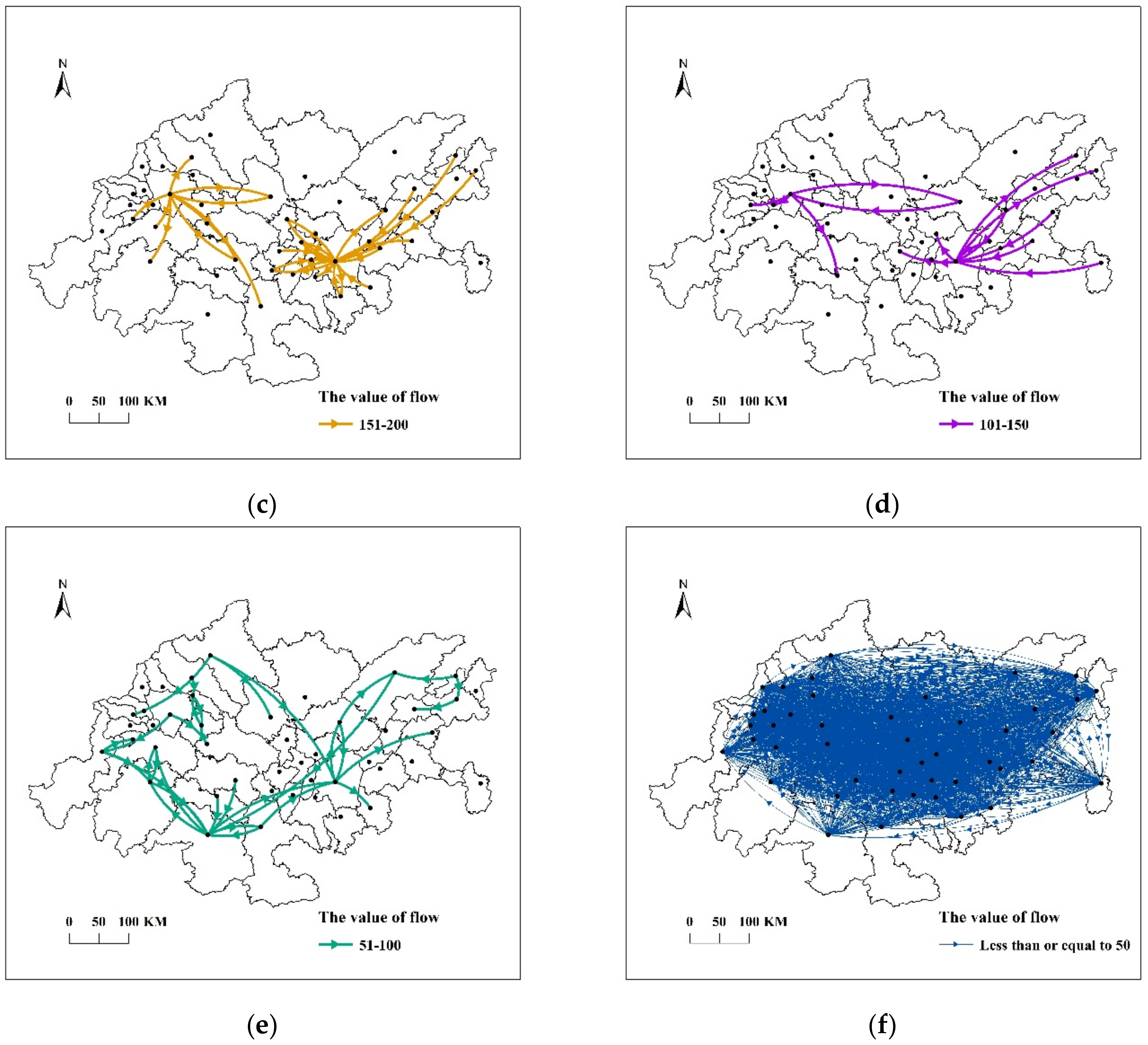
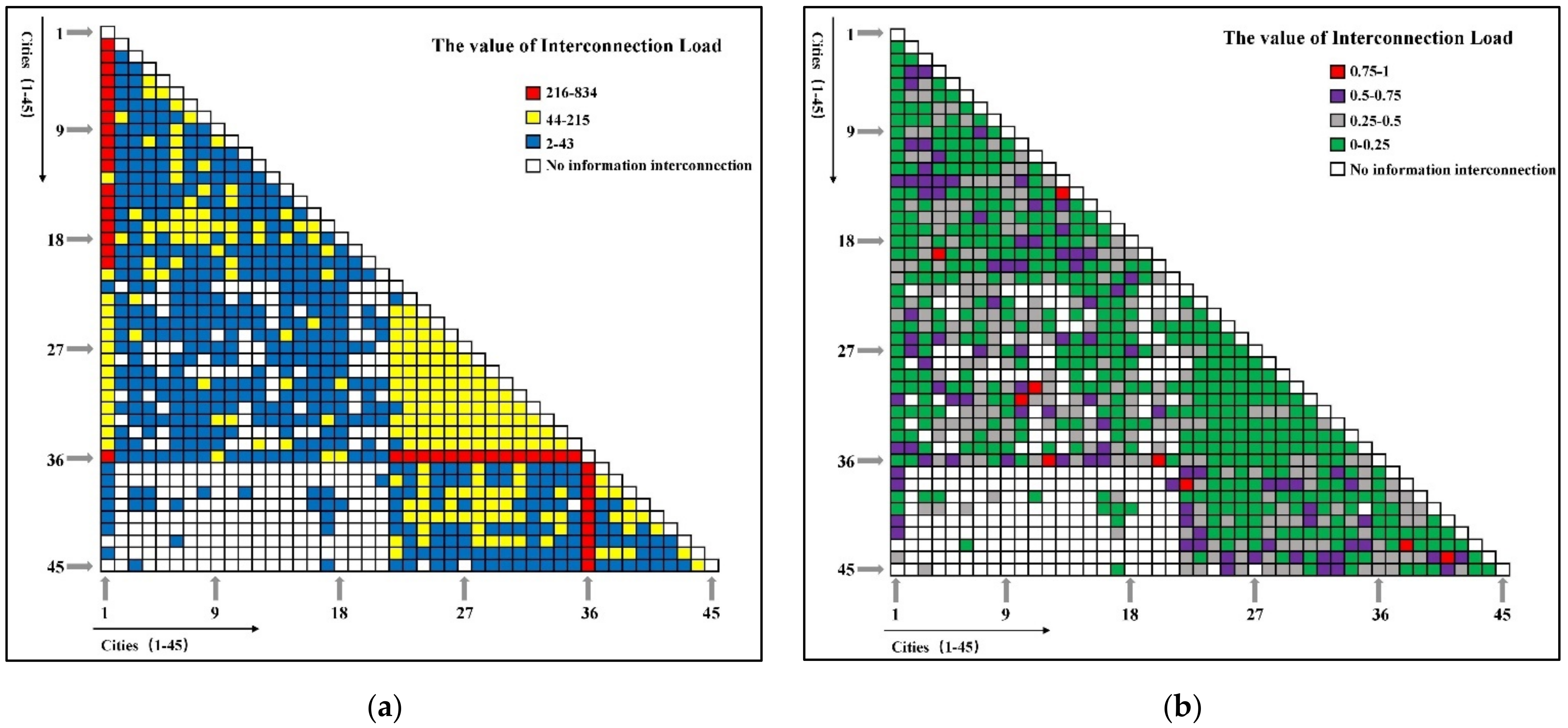
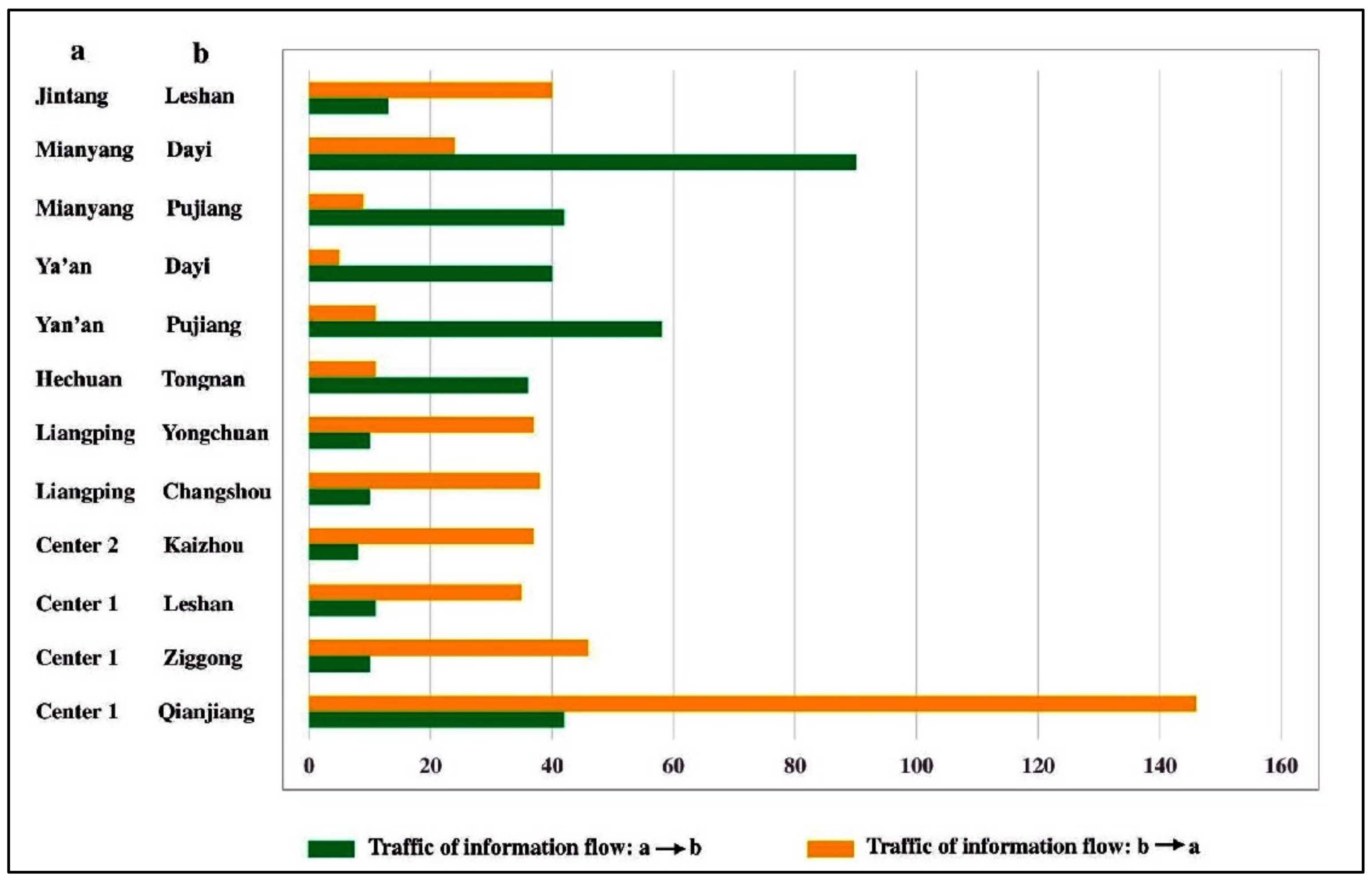
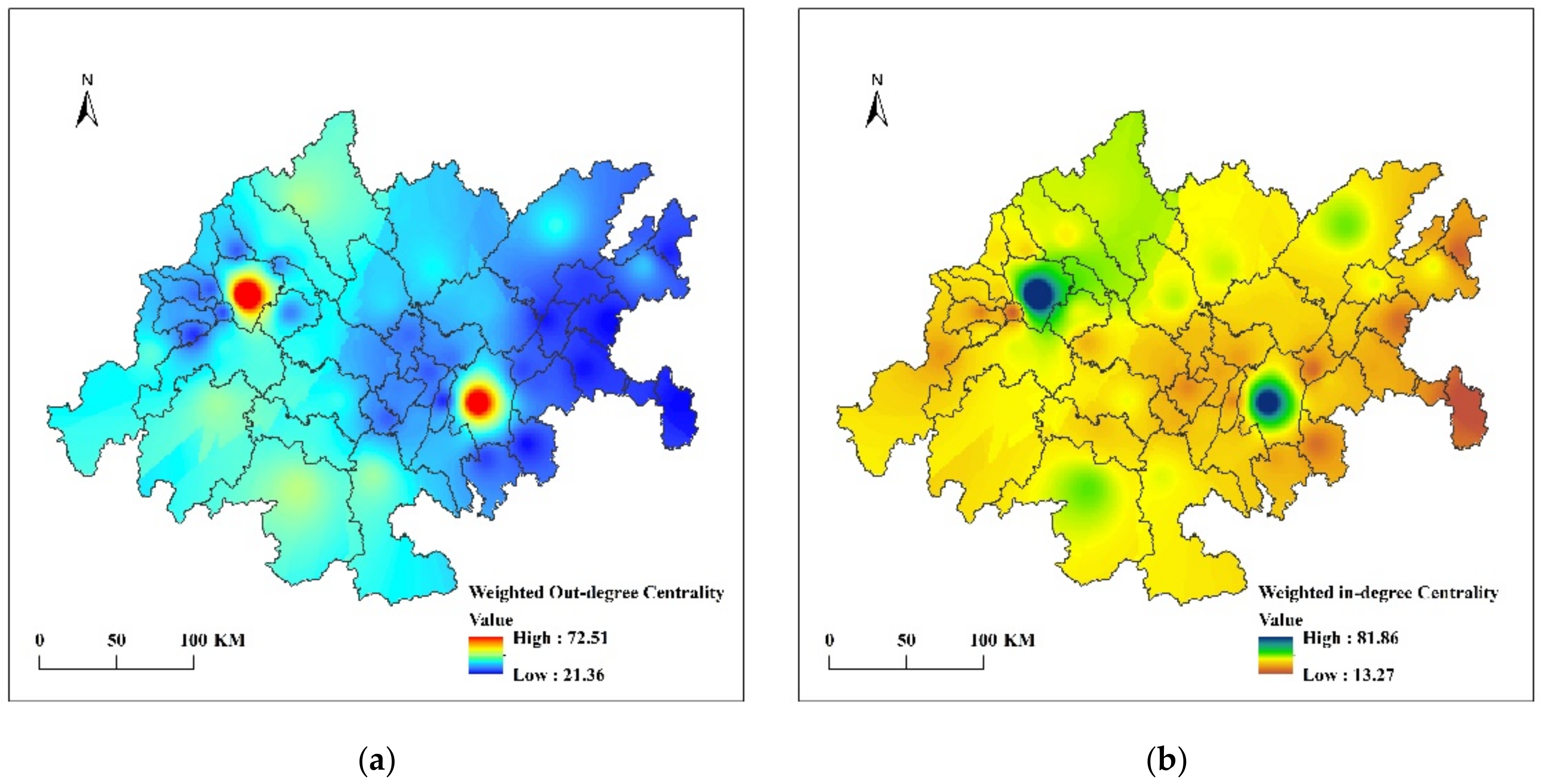
| Factor | Differences of the Weighted Out-Degree Centrality | Differences of the Weighted in-Degree Centrality |
|---|---|---|
| Standardized Coefficients | Standardized Coefficients | |
| Year-end resident population | −0.0362 | −0.0299 |
| GDP per capita | −0.0136 | 0.0549 |
| Contribution rate of tertiary industry | 0.0278 * | 0.0173 |
| Expenditure of public finance | 0.4074 | 0.1981 |
| Number of high-speed trains | 0.6144 *** | 0.6798 *** |
| Number of mobile phone users per 100 people | 0.0429 * | 0.0921 ** |
| Adj R-Sqr | 0.931 | 0.865 |
| Number of replacement | 2000 | 2000 |
Disclaimer/Publisher’s Note: The statements, opinions and data contained in all publications are solely those of the individual author(s) and contributor(s) and not of MDPI and/or the editor(s). MDPI and/or the editor(s) disclaim responsibility for any injury to people or property resulting from any ideas, methods, instructions or products referred to in the content. |
© 2022 by the authors. Licensee MDPI, Basel, Switzerland. This article is an open access article distributed under the terms and conditions of the Creative Commons Attribution (CC BY) license (https://creativecommons.org/licenses/by/4.0/).
Share and Cite
Xiao, C.; Liu, C.; Li, Y. Directional and Weighted Urban Network Analysis in the Chengdu-Chongqing Economic Circle from the Perspective of New Media Information Flow. ISPRS Int. J. Geo-Inf. 2023, 12, 1. https://doi.org/10.3390/ijgi12010001
Xiao C, Liu C, Li Y. Directional and Weighted Urban Network Analysis in the Chengdu-Chongqing Economic Circle from the Perspective of New Media Information Flow. ISPRS International Journal of Geo-Information. 2023; 12(1):1. https://doi.org/10.3390/ijgi12010001
Chicago/Turabian StyleXiao, Changwei, Chunxia Liu, and Yuechen Li. 2023. "Directional and Weighted Urban Network Analysis in the Chengdu-Chongqing Economic Circle from the Perspective of New Media Information Flow" ISPRS International Journal of Geo-Information 12, no. 1: 1. https://doi.org/10.3390/ijgi12010001





